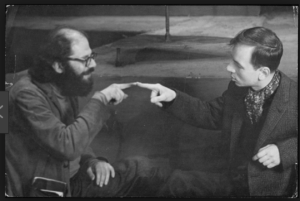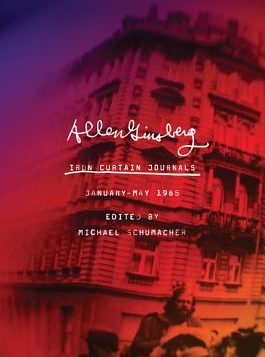 Iron Curtain Journals: January–May 1965
Iron Curtain Journals: January–May 1965
by Allen Ginsberg
Edited by Michael Schumacher
Univ. of Minnesota Press. 400 pages, $29.95
I was not surprised that Ginsberg had substituted his own “mantra” for the Tibetan “Om Mani Padme Hum” (“Jewel in the Heart of the Lotus”). He was what used to be called “an original” who lived on his own Planet Ginsberg. Born in Newark, New Jersey, in 1926, the author of Howl (1956) and Kaddish (1961) was friends with all of the Beats: Carl Solomon, Neal Cassady, Jack Kerouac, William Burroughs, Herbert Huncke, Lawrence Ferlinghetti, Gregory Corso, and his longtime partner Peter Orlovsky. Howl contained references to homosexuality and illegal drugs, and his publisher Lawrence Ferlinghetti was arrested in 1957 for publishing the book. At the resulting obscenity trial, the judge ruled that the poem was permissible because it had “redeeming social value.”

Courtesy the Allen Ginsberg Estate.
The first volume offers a glimpse into Ginsberg’s thought processes as he traveled to Cuba, Prague, Poland, Russia, and England at the height of the Cold War, long before the fall of the Soviet Union in 1991. From the journals we learn about his meetings with young people, literary colleagues, and government officials. His public questioning of repressive state policies regarding homosexuality, drugs, and free speech eventually led to his expulsion from all of the Iron Curtain countries.
Ginsberg wrote several moving journal entries when in Russia as he attempted to make contact with the remnants of his extended family (both of his parents came from Russia). We find him deeply moved when in Poland to visit the site of the Warsaw Ghetto and Auschwitz. He ended his journey in London, where he was involved in a mass cultural event—an international poetry festival held in Prince Albert Hall. Seven thousand people attended this poetry “be-in.”
From these journals, we get a picture of Ginsberg as a cultural provocateur who was willing to challenge repressive authority wherever he encountered “cultural commissars,” and he was willing to risk beatings, jail, and deportation to express what he believed in. Contained within the journals are first drafts of several well-known poems, including “Who Be Kind To” and “Kral Majales.” This collection is highly recommended for Ginsberg aficionados as well as those interested in the Beat generation and its message of individuality and freedom.
_________________________________________________
Irene Javors, a frequent contributor to this magazine, lives in Queens, New York.






